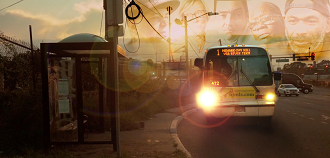
The #1 Bus Chronicles 2020
Distributed by Third World Newsreel, 545 Eighth Avenue, Suite 550, New York, NY 10018; 212-947-9277
Produced by Joel Katz
Directed by Delmira Valladares
Streaming, 55 mins
General Adult
Incarcerated Persons; Poverty; Transportation; Urban Areas
Date Entered: 02/22/2022
Reviewed by Timothy Hackman, University of Maryland Baltimore County“Gotta be pretty tough to ride the 1 Bus,” says an unnamed man at the beginning of The #1 Bus Chronicles, an intimate look into the lives of people who navigate this particular New Jersey Transit bus route along Highway 1, the oldest interstate highway in the United States. In the heart of an industrial zone that was once the center of a thriving shipbuilding industry, on a route that also includes Jersey City and the Hudson County Correctional Facility, the #1 Bus carries working class people to jobs at factories and warehouses, students to courses at Jersey City University, family members and volunteers to visit inmates at the jail, and released prisoners and detainees to an uncertain future. Through interviews with the individuals who ride the #1 Bus, this film tells the story, often heartbreaking and hopeful in equal measures, of life on the fringes of one of America’s great urban centers.
The #1 Bus Chronicles is well shot, with good production values, and the interview audio is crisp despite the cacophony of background noise inherent in filming at a bus stop on an industrial highway. Its choice of interview subjects is also compelling. We first meet Chris, a Black 55-year-old warehouse worker. Chris leaves his house at 4:00am each day to take multiple buses and trains, ending his two-hour commute with his ride on the #1 Bus. The camera takes a break with Chris as he fishes in a stream on a day off, and he tells the story of growing up in segregated Mineral, Virginia, in a family descended from slaves. A military veteran with service in his blood – Chris’s father was killed in Vietnam and his grandfather was killed in Korea – Chris ended up serving seven years in a New York state prison. His dream is to retire from his warehouse job and move back to Virginia, where he will have more time to hunt and fish. In one endearing segment, Chris tells the story of delivering a baby on the #1 Bus, while the story is told (in a PG-friendly way) using a simple black and white cartoon.
Between the interview segments there are brief interludes, such as the ‘Quick Guide to #1 Bus Footwear” –heavy boots identify a construction worker, sneakers without laces denote someone just out of jail or immigrant detention, flip flops and painted toenails adorn a woman on her way to visit a boyfriend in jail, a pair of loafers carries the message, “no story, just waiting.” There is a brief history of Kearny and its role in the shipbuilding industry during World War II, including some great photos of the area and buses going back to the 40s. “Bus Stop People” features smiling portraits of the diverse riders of the #1 Bus, although a man’s voice-over interview hints at the pain and frustration behind the smiles: “We should have more buses out here, man. These are hardworking people. I pay my $1.60, my feet hurt, I jump off the truck, I gotta stand here an hour, hour and a half. It sucks!”
Other interviewees include Deborah (pronounced Deb-OR-ah, or just “Dee,”) a single mom riding the #1 Bus to classes at Jersey City University, where she hopes to complete her degree and become a drug and alcohol counselor. As she rides, she reads and highlights articles for her coursework. The only member of her family to go to college, Deborah is desperate to finish her education but is not sure her financial situation will allow it. “This is not the end of my story,” she says proudly. Carlos is a first-generation child of Cuban immigrants who is completing a year-long work release program at Hudson County Correctional Institution. He rides the #1 Bus from the jail to his college classes and back again each day. In one segment he reads from the newspaper story about how he and a friend were shot multiple times, leaving him with injuries that led to an addiction to painkillers. We also meet Jonathan and Leslie, two of the rare White passengers on the #1 Bus. Leslie is a volunteer with First Friends, a group that visits and advocates for undocumented incarcerated people and refugees in the nearby jail. From her we learn that detainees are released with only the clothes they had when they arrived, no matter the weather; often they end up at the #1 Bus stop in just a t-shirt, jeans, and sneakers. Jonathan lost his long-time job at a used bookstore and is starting over. In order to qualify for food stamps assistance he takes the bus five days a week to computer classes with a program called Urban Renewal.
We learn much more about each of these #1 Bus riders during the film, including their histories, their hopes, their progress and their setbacks. The film does an admirable job of letting each person speak their own story in a way that lets their individuality and humanity shine through. Overall, it is recommended for viewers with an interest in documentary films generally, for those who study urban poverty or social work, or for politicians who still do not understand the need for safe, reliable public transportation as an engine of economic development and as a lifeline for the working class.
Awards: Best Documentary, Golden Door International Film Festival, Jersey City; Creativity Award, Show for Change Festival; Director’s Choice, Black Maria Film Festival
Published and licensed under the Creative Commons Attribution 4.0 license. Anyone can use these reviews, so long as they comply with the terms of the license.